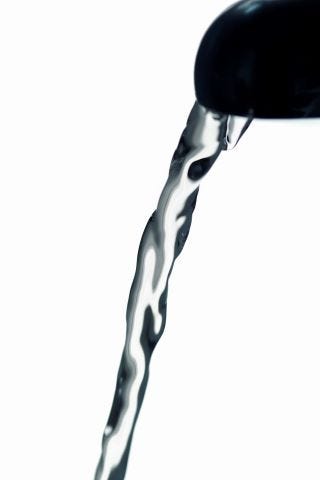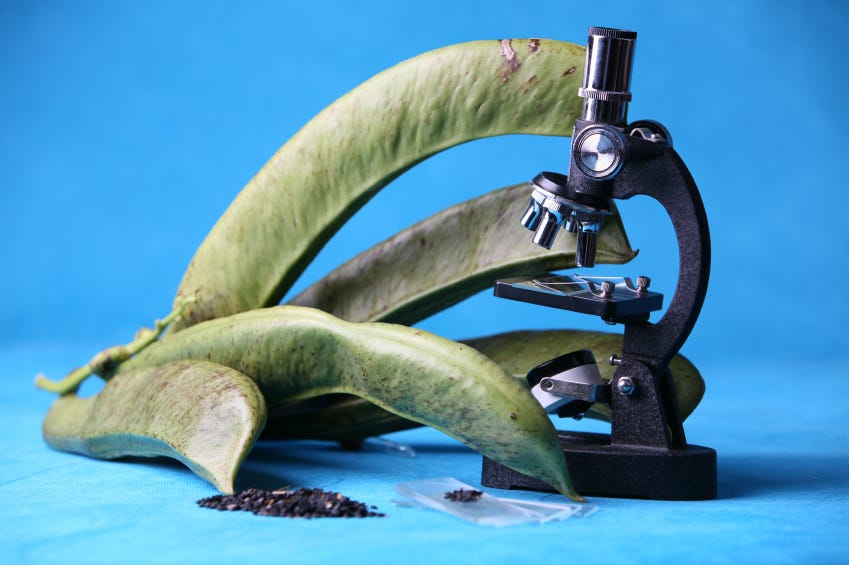1 Week, 7 Stories #30
The rise of the trades, the crash of infrastructure, and the impact of heat.
Every edition features 7 stories, from the past week. I’ll draw on my background in media, journalism, agriculture, biotech, and renewable energy to come up with an interesting selection and to offer some context.
This week I was reminded of Peggy Lee singing that “The rich get rich, and the poor get poorer, In the meantime, in between time, Ain't we got fun?” and decided it was going to be at the top of this week’s lineup.
So kick back with a coffee – or tea if you insist – and read on.
On Thursday, Donald Trump met with prominent and wealthy businesspeople to gain their support and of course, their money. And they were eager to line up for their chance to meet and greet according to a Bloomberg story.
That is not surprising and not necessarily a bad thing. Executives and lobbyists need to make sure they both understand, and are ready to work with, a potential president. US presidential elections are expensive so looking to the rich and famous to fund an electoral campaign is important.
Where it becomes a concern is knowing what is being traded in those interactions. The rise of Russian oligarchs (a good NPR story btw) going back to the Cold War is an example of how it can go off the rails and move the balance of power from citizens, elections and politicians into the hands of an elite. Usually with a personal or corporate profit motive.
We already have a widening gap between the haves and the have-nots, which the Centre for Social Justice fears is becoming a “chasm”. In Canada that gap is widening at what StatsCan said last year was a record pace. An article in The Conversation by 4 academics (including one from the University of Calgary) points out that most wealth in Canada is held by relatively few households.
Globally the picture is worse, and Oxfam put it into perspective earlier this year:
Meanwhile Elon Musk is worried that his $56 billion pay package will be turned down while we stare in disbelief at the “haves and the have-yachts” having their say and often their way.
Nevertheless, billionaires who see rich Donald Trump as a victim will continue lining up to curry favour lest they too find themselves struggling to find an affordable home to rent.
In Canada and the US, a skilled labour shortage is due in part to something we hear a lot about lately. Retirement. Those leaving are outpacing those entering. However the Wall Street Journal said this week that Gen Z plumbers and construction workers are making blue collar cool as young workers start to question the value of a four-year degree. In the US these new tradespeople have even been dubbed the “toolbelt generation” and needless to say those new kids on the block like their social media.
Forbes reports the new blue-collar crowd are finding more job satisfaction with less student debt, more entrepreneurial opportunities, and the chance to start earning good wages earlier in their careers. They may prove to be AI proof as well because chances are a piece of AI software is not going to be making house calls to fix a leaky faucet or climb on the roof to install a solar panel.
In Alberta where the oil & gas sector needs skilled trades workers, enrollment in those related programs are back above pre-pandemic levels with electricians and heavy equipment technicians topping the in-demand list. This week the Ontario government said it would be investing $4.7 million to provide free training for youth, apprentices and jobseekers looking for careers in the skilled trades.
While we are increasing training programs (and interest) in the trades, there is still a mismatch when it comes to bringing in those much-needed young workers from abroad. Growth is almost flat in the number of international students enrolling in trade and vocational programs compared to the surge in business, management, marketing, computing, and IT.
Buckle up your toolbelt for an interesting shift in the job market, and if you know someone looking to get into a skilled trade who else better to turn to for advice than one of the most well-known in the field - Mike Holmes.
Environment and Climate Change Canada has posted its seasonal outlook for this summer and it is more of what we are unfortunately, getting used to. Hot and dry. The only region likely to get a break is coastal BC. (you can watch the technical briefing here)
The rest of the planet is going to experience the same, if not worse. Enter the Chief Heat Officer.
This new job is usually a public servant at the municipal level who is in charge of helping people deal with extreme heat and reduce the effect of urban heat islands, often with an emphasis on the poor and disadvantaged who tend to be disproportionately affected by extreme heat.
Bloomberg News refers to these new professionals as “stewards of city life” and has a good story on how they are forming a network and sharing ideas and strategies to deal with life-threatening heat waves. None of the officers mentioned in the story were Canadian and as I continue to dig around, have not come up with any Canadian cities with a Chief Heat Officer. That doesn’t mean we are ignoring the problem. Under the watch of chief medical officers or public health officers, many of the same actions seem to be covered.
And it is important to make sure the situation is covered because as the CHO for Miami-Dade County says in the Bloomberg story, “… when we get even small increases in our heat index, it can make people more vulnerable”.
My take on the role of Chief Heat Officer so far is that they seem to be predominantly women, perhaps because globally, women are part of the disproportionality affected by what the Context says is an “era of global boiling”.
We have already seen severe heat waves in 2024 and in North America we have not even hit the hottest time of the year. You’ll need more than a sunhat and a hand on the air conditioning switch to cope.
I spent a significant part of my career working in radio and it treated me well, so no surprise the RadioWorld headline, Dude, Where’s My Car Radio? got my attention this week. In-car radios have been on carmakers’ hit list for a while now, but the increase in electric vehicle (EV) sales and popularity have created even more static for the medium. Though it will be an option on higher end models, Stellantis and Renault are ditching the tuner on standard model EVs in Europe. AM radio is prone to electromagnetic interference from within the electric vehicle itself so manufacturers would prefer to skip the technical challenges (and cost) and push drivers into using Bluetooth connections to their own devices.
Yet, radio remains popular in our cars. The latest Infinite Dial 2024 report from Edison Research found that 70% of adults 18+ said they had driven or ridden in a car in the past month tuned to an AM or FM station. The Jacobs Media 2024 survey revealed that listening to broadcast radio in cars exceeded satellite radio and guess what, most radio listening among Millennials and Gen Zs takes place in cars.
There are 700+ commercial radio stations in Canada, not to mention public and community-based stations that together reach more than 85% of Canadians. When people get into their cars, they tune in because radio is easy to listen to in the car, it’s free, they find out what’s going on locally, and are kept informed. When it comes to streaming radio, more Canadians stream live radio than they do Spotify.
An emergency event can easily knock out WiFi, Internet, or cell phone connections, but chances are radio will still be broadcasting. In the US it is considered a vital enough service that bill S.1669 - AM Radio for Every Vehicle Act of 2023 is working its way the Senate. It has broad bipartisan support and endorsement from organizations such as the American Farm Bureau Federation which says rural America relies on radio for weather, information, and in times of emergency.
I have a couple of radios sitting on the shelf behind me in the basement writing bunker and the car radio is always on when I’m driving. With any kind of luck there will still be a radio in my next vehicle.
The recent water main break in Calgary should remind us that the way of life we enjoy is surprisingly fragile. In what was described as a “catastrophic” break of a main feeder pipe on June 5th, people in Calgary and a few surrounding communities found themselves in danger of running out of water. The 11 km (6.8 miles) long and 2-metre-wide (6.5 feet) pipe cut off water coming from one of the city’s two water treatment plants. A boil water advisory was in effect for one urban community and it will be sometime next week before repairs are completed. Until then the city has closed aquatic centres, implemented an outdoor watering ban, imposed a fire ban, and has been asking Calgarians to make major cuts to their indoor water use.
That is one major incident in one major city.
The problem of aging water infrastructure however is widespread.
Climate change has made storms more severe and stressed how runoff can be handled.
Droughts are drying up supplies.
After studying 800 American and Canadian water providers, a Utah State University report said the 2 countries experience about 260,000 water main breaks per year. The report also said nearly 20% of water mains in the U.S. and Canada are past their life span and have not been replaced because of costs. The utilities that participated in the study served roughly 30% of the population in the two countries so the problem is likely much worse than what was uncovered. Other studies suggest that a water main breaks every 2 minutes somewhere in the US losing 6 billion gallons (22,712,470,704 litres) of water per day. Calgary alone has 15,000 km (9,320 miles) of underground water services, and we complain every time we are inconvenienced by repairs or maintenance. Multiply that by every city and town in North America and consider how much work is needed to keep all that infrastructure working properly and we might consider doing more to conserve and complaining less.
70% of the world’s freshwater is used for agriculture, 19% for industrial use, and 11% for domestic use according to an article from the Council on Foreign Relations. That same article says that for every 1°C (1.8°F) increase in the global average temperature, we could experience up to a 20% drop in water resources.
Canada cannot even guarantee clean and safe water supplies across the country and globally, 1 in 10 people do not have access to clean water. We are facing the convergence of a supply problem, an infrastructure problem, and an access problem.
The Economist said that water stress is not being matched by political awareness or investment. The recent experience in Calgary should serve as an example of how little it takes to significantly change our way of life and how woefully unaware we are of how big a problem we are facing.
As the previous story noted, 70% of the world’s freshwater is used for agricultural purposes. Canada has 758,516 hectares of land under irrigation and Alberta accounts for almost three-quarters of that total. The numbers are going up and we are definitely not on the verge of fixing the climate, so we need crops that do not suck up so much water.
The work to produce more drought-resistant crops is well underway and genetics holds the key. The modern varieties of potatoes need lots of moisture at between 30 and 90 days in their growth cycle, so finding a drought-resistant potato is important. A CBC story this week says that research taking place in PEI is looking back to varieties from South America where potatoes originated. By analyzing the DNA of these varieties which evolved over centuries to handle extreme conditions, researchers have identified the genetic markers which control drought-resistant characteristics and plant growth. The research team has also hooked up with food scientists to make sure there is also a consumer focus in the research. No sense building a better spud if no one will eat it.
Also on the wish list for drought tolerance in agriculture, are improved varieties of wheat. A researcher at the University of Calgary is using gene editing in the search for a wheat strain that can handle drought conditions. Wheat is a staple for 35 per cent of the world's population but it has a complex genome that makes it difficult to hone in on specific traits. It is a water guzzler. When Canada relaxed its rules on gene edited crops in 2021 it gave some added impetus to develop wheat that could deal with changing climate conditions.
Because of its heavy water use and re-occurring drought around the world, the agricultural sector was already facing a PR battle, but it also needs disaster proof crops to keep the industry and the planet healthy.
What’s in a name? An elephant by any other name is still an elephant, right? (sorry Mr. Shakespeare) Unless you happen to be chatting with another elephant.
Elephants were already viewed as being both emotionally and socially complex and we now have even more evidence. An international research team says that elephants have individual names for each other. A peer-reviewed paper in Nature Ecology & Evolution this week says that “that wild African elephants address one another with individually specific calls”. The researchers used machine learning to identify 469 distinct calls in recordings and when played back to elephants they responded.
The elephants are not just mimicking sounds made by the other recipient elephant as is the case with Rocky the Great ape who learned how to mimic researchers from Durhan University. And it goes beyond sound, colours, posture, touch, or release of odours.
The Economist even goes so far as to say that our view of “anthropoexceptionalism takes another tumble”.
So a shout out this week to elephants. Whatever your names is.
Read, comment, subscribe, and share this newsletter.
I’m available for contract and freelance work with not-for-profits and charities. With 40 years of experience behind me and lots of time ahead of me, I’m here to help you make a difference in your media relations, public relations, and general communications needs.






